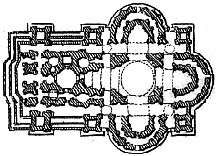Domenico (Bernabei), da Cortona (called Boccador)
b. 1465; d. about 1549.
He derived his name from the city of Cortona in Italy. Mariette gives Bernabei as the family name, and says that Domenico was a pupil of Giuliano di San Gallo. He was brought to France by Charles VIII, and in the accounts of that king is called faiseur de chasteaulx et menuisier. In the accounts (dépenses secrètes) of François I there is an entry concerning payment to him for engineering work, bridges, mills, and the like, done at the châteaux of Tournai, Ardres, and Chambord. On this record has been based the erroneous assumption that he drew the original plans for the château of Chambord (see Nepveu). An inscription which formerly existed over the main portal of the old Hôtel de Ville in Paris, which was destroyed by the Commune, May 24, 1871, ended with the words Domenico Cortonensi Architectante. It has also been the accepted tradition since Sauval that Domenico designed the central portion of the façade of the old Hôtel de Ville. Modern criticism, however (Vachon, Palustre), gives him simply the position of consulting or associate architect (see Sebastiano Serlio and Fra Giocondo), and ascribes the authorship of the Hôtel de Ville to Pierre Chambiges (I).
Giulio Pippi (Giulio Romano)
painter and architect; b. 1492; d. 1546.
As the principal assistant of Raphael he was associated with him in executing the frescoes of the Stanze of the Vatican. He also superintended the execution of the frescoes in the loggia of the Farnesina (finished about 1518). He assisted in the decoration of the Loggia of the Vatican, and of the Villa Madama, near Rome. In 1525 he designed the Palazzo del Te (abbreviation for Tejetto, a sluiceway or canal) at Mantua (finished 1528). Giulio built his own palazzo, which still stands in Mantua, and the tomb of Baldassare Castiglione in the church of S. Maria delle Grazie (Mantua).
Antonio da San Gallo, Sangallo (II) (Antonio Ficconi)
architect; b. 1485; d. October 3, 1546.
Antonio II was the son of a sister of Giuliano and Antonio (I) da San Gallo. His name was Picconi. He was employed by Bramante as a draughtsman, and assisted Giuliano da San Gallo at S. Peter's church, and in 1517 was made Raphael's associate in the superintendence of that building. May 1, 1518, he was appointed architect of the church and the Vatican palace, and retained that office until his death. The model which he made for S. Peter's is still in existence. Antonio was for many years the leading architect in Rome, and controlled a large military and civil practice. He had in hand at one time the fortresses of Florence and Ancolia, the completion of the buildings at Loreto (see Sansovino, Andrea), the enlargement of the Vatican, and the fountain and aqueduct at Orvieto. The villa Madama, Rome, is attributed to Raphael by Vasari, but existing drawings by Antonio and his brother, Battista, indicate that much of the work was done by them about 1530. About 1542 he built for Paul III (Farnese, Pope 1534-1549), the Pauline chapel in the Vatican, which was decorated by Michelangelo. For the same pope, also, he began the famous Farnese palace in Rome. At about the beginning of the third story, the work was transferred to Michelangelo, whose design for the cornice was preferred. A long list of Antonio's palaces and churches is given by Vasari. Many of his drawings are in the gallery of the Uffizi (Florence).
| |

Third plan of the Church of St. Peter, composed by Antonio Sangallo, called the younger or the nephew, who, after the retirement of his uncle Julian, succeeded him as architect of St. Peter. This plan, in which Sangallo wished to re-establish the Latin cross, as imagined by Bramante, was in all respects inferior to the plans of his predecessors. It was therefore abandoned after his death in 1546.
Seroux
| |
|